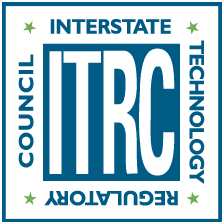About ITRC
The Interstate Technology and Regulatory Council (ITRC) is a state-led coalition working to reduce barriers to the use of innovative environmental technologies and approaches so that compliance costs are reduced and cleanup efficacy is maximized. ITRC produces documents and training that broaden and deepen technical knowledge and expedite quality regulatory decision making while protecting human health and the environment. With private and public sector members from all 50 states and the District of Columbia, ITRC truly provides a national perspective. More information on ITRC is available at www.itrcweb.org.
ITRC is a program of the Environmental Research Institute of the States (ERIS), a 501(c)(3) organization incorporated in the District of Columbia and managed by the Environmental Council of the States (ECOS). ECOS is the national, nonprofit, nonpartisan association representing the state and territorial environmental commissioners. Its mission is to serve as a champion for states; to provide a clearinghouse of information for state environmental commissioners; to promote coordination in environmental management; and to articulate state positions on environmental issues to Congress, federal agencies, and the public.
Disclaimer
This material was prepared as an account of work sponsored by an agency of the United States Government. Neither the United States Government nor any agency thereof, nor any of their employees, makes any warranty, express or implied, or assumes any legal liability or responsibility for the accuracy, completeness, or usefulness of any information, apparatus, product, or process disclosed, or represents that its use would not infringe privately owned rights. Reference herein to any specific commercial product, process, or service by trade name, trademark, manufacturer, or otherwise does not necessarily constitute or imply its endorsement, recommendation, or favoring by the United States Government or any agency thereof. The views and opinions of authors expressed herein do not necessarily state or reflect those of the United States Government or any agency thereof and no official endorsement should be inferred.
The information provided in documents, training curricula, and other print or electronic materials created by the Interstate Technology and Regulatory Council (“ITRC” and such materials are referred to as “ITRC Materials”) is intended as a general reference to help regulators and others develop a consistent approach to their evaluation, regulatory approval, and deployment of environmental technologies. The information in ITRC Materials was formulated to be reliable and accurate. However, the information is provided “as is” and use of this information is at the users’ own risk.
ITRC Materials do not necessarily address all applicable health and safety risks and precautions with respect to particular materials, conditions, or procedures in specific applications of any technology. Consequently, ITRC recommends consulting applicable standards, laws, regulations, suppliers of materials, and material safety data sheets for information concerning safety and health risks and precautions and compliance with then-applicable laws and regulations. ITRC, ERIS and ECOS shall not be liable in the event of any conflict between information in ITRC Materials and such laws, regulations, and/or other ordinances. The content in ITRC Materials may be revised or withdrawn at any time without prior notice.
ITRC, ERIS, and ECOS make no representations or warranties, express or implied, with respect to information in ITRC Materials and specifically disclaim all warranties to the fullest extent permitted by law (including, but not limited to, merchantability or fitness for a particular purpose). ITRC, ERIS, and ECOS will not accept liability for damages of any kind that result from acting upon or using this information.
ITRC, ERIS, and ECOS do not endorse or recommend the use of specific technology or technology provider through ITRC Materials. Reference to technologies, products, or services offered by other parties does not constitute a guarantee by ITRC, ERIS, and ECOS of the quality or value of those technologies, products, or services. Information in ITRC Materials is for general reference only; it should not be construed as definitive guidance for any specific site and is not a substitute for consultation with qualified professional advisors.
January 2023


